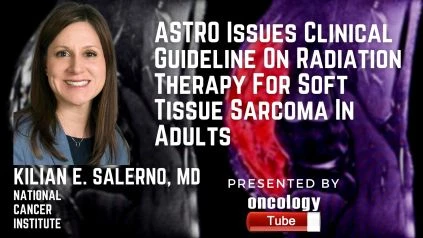Kilian E. Salerno, MD, vice chair of the guideline task force and a radiation oncologist at the National Cancer Institute speaks about ASTRO Issues Clinical Guideline On Radiation Therapy For Soft Tissue Sarcoma In Adults.
Link to Article:
https://www.astro.org/News-and-Publications/News-and-Media-Center/News-Releases/2021/ASTRO-issues-clinical-guideline-on-radiation-thera
Link to ASTRO Guidlines:
https://www.practicalradonc.org/article/S1879-8500(21)00118-1/fulltext
The American Society for Radiation Oncology (ASTRO) has released a new clinical guideline on the use of radiation treatment to treat adult patients with soft tissue sarcoma (STS). Patients with localized, operable STS of the trunk (i.e., chest wall, abdominal wall) and extremities (i.e., arms, legs) should receive optimal radiation dosage, methods, and treatment planning, with an emphasis on maintaining long-term functioning via personalized care. The use of radiation therapy in the treatment of retroperitoneal sarcoma is also discussed in the recommendation. Practical Radiation Oncology released the recommendation, which is ASTRO’s first for sarcoma.
While soft tissue sarcomas are uncommon, accounting for around 1% of all adult cancers, they are potentially fatal tumors with more than 50 distinct subtypes. These tumors develop in the body’s connective tissues, such as muscles, blood vessels, fat, and nerves, and can appear anywhere on the body, including the hands and feet, where more frequent carcinomas do not grow.
STS needs a multidisciplinary team of surgical, orthopedic, medical, and radiation oncologists, as well as specialist pathologists and radiologists, to provide nuanced and coordinated treatment. Because not all patients can be treated at high-volume facilities with physicians who are familiar with these uncommon cancers, detailed recommendations are necessary to guide treatment decisions.
Surgical resection is the standard treatment for STS, with radiation therapy added for individuals who are at a higher risk of recurrence. Previously, radiation treatment was administered after surgery, but this has changed to favor preoperative radiation therapy. While both preoperative and postoperative treatments have low local recurrence rates, long-term adverse effects differ depending on when radiation is given in relation to surgical resection.
The guideline’s recommendations include patient selection for radiation treatment as well as dosage, sequencing, planning, and imaging guidance for extremity and superficial truncal STS, as well as retroperitoneal sarcomas, which have a poorer prognosis than those in the extremities. The guideline also emphasizes the need for collaboration across multidisciplinary care teams in the planning and delivery of patient care. The following are some key recommendations:
* Radiation therapy is recommended for patients with primary, localized extremity, and truncal soft tissue sarcomas who have a high risk of local recurrence, based on a multidisciplinary assessment of the tumor’s pathology, location, and size; final or expected surgical margins, and other factors detailed in the guideline. For individuals with a low risk of local recurrence, radiation treatment is usually not advised.
* Preoperative radiation treatment is suggested for individuals who need surgery and radiation therapy. Only in specific clinical circumstances, such as the discovery of unanticipated adverse pathologic features following oncologic resection or unplanned excision, or when the risk of wound healing complications outweighs the risk of long-term, permanent side effects, is postoperative radiation therapy recommended. The treatment algorithms for initial local management (Figure 1) and local management following an unplanned excision are also included in the guideline (Figure 2).
* The regular use of radiation treatment in addition to oncological resection is conditionally not advised for patients with primary localized retroperitoneal sarcomas (RPS). Patients with RPS who are at high risk of local recurrence may benefit from targeted radiation treatment. Preoperative radiation is preferred when radiation therapy is needed in certain specific circumstances.
* The guideline includes suggestions for imaging guidance and patient posture, as well as optimal dosage, fractionation, target delineation, and delivery procedures for preoperative and postoperative radiation treatment, with a focus on patients’ long-term functional results.

